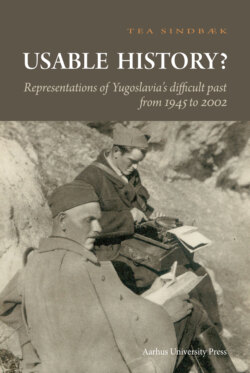Читать книгу Usable History? - Tia Sindbaek - Страница 31
На сайте Литреса книга снята с продажи.
Tito’s 1948 report of the war
ОглавлениеIn 1948, the Yugoslav communist leadership was forced to state even more explicitly how recent Yugoslav history, the Second World War and the communist seizure of power in particular, were to be understood.
By then the communist regime was solidly established, the reconstructing of the country according to Stalinist ideals was developing quickly, and all possible competitors for power and ideological influence were effectively eliminated. Used to seeing themselves as the vanguard of Stalinism outside the Soviet Union, the Yugoslavs had also been granted the honour of hosting the Cominform headquarters, which was established in Belgrade in 1947.
Yet, during Spring and early Summer 1948, the self-perception of the Yugoslav communists was badly shaken by Soviet-Yugoslav disagreements and severe incriminations from the Kremlin, claiming, amongst others, that the Yugoslav communists overestimated their own success in the National Liberation Struggle and that their victory was in fact caused by the efforts of the Soviet Red Army.44 On 28th June 1948 Yugoslavia was formally expelled from the Cominform, its communist leadership accused of incorrect policies, anti-Soviet attitudes, revisionist, Trotskyist and Menshevik tendencies, petty bourgeois nationalism and betrayal of the international solidarity of the working people.45
The split deprived the Yugoslav communists of their external source of legitimacy as part of the victorious international communist movement. This meant that they had to stress their internal sources of justification even further, and the National Liberation Struggle now, besides justifying the construction of the new federal state and supplying heroic national myths for the communists, also had to serve as a proper autochthonous socialist revolution.46 While feverishly denouncing the critique of their party and politics, the Yugoslav communists guarded and exploited the image of the National Liberation Fight.47
In July 1948, shortly after the expulsion from the Cominform, the Communist Party of Yugoslavia held its fifth Party Congress, largely with the aim of proving and securing Party unity in the face of the crisis. For more than eight hours, Tito explained the history of the Yugoslav communists, partly meeting some of the Soviet criticism, while stressing wartime solidarity and post-war achievements.48 This speech, according to one historian, summed up “the pragmatic consensus of communist historical interpretation” and its version of Yugoslavia’s 20th century history was to dominate institutional historiography through the following decades.49
In Tito’s report, the warring parties are depicted as the ‘heroic Partisans’ on the one side and on the other an almost undifferentiated group of ‘occupiers’, ‘quislings’ and ‘collaborators’. The enormous sacrifices and superhuman efforts of the Yugoslav peoples are repeatedly emphasised. Through the 75 pages of Tito’s speech concerned with the period of the Second World War, war crimes and massacres are regularly mentioned as part of a general and well-known background to the Partisan warfare, but they are seldom discussed in more than one sentence:
Explaining the beginning of the war, Tito states:
When the Ustasha started already in the month of May to commit the mass slaughtering of Serbian citizens in Bosnia and Herzegovina, in Lika, and in Kordun, and the people started to flee into the hills and forests to save their lives, the party sent its staff to take the leadership of this unfortunate people, in order to resist the bestial Ustasha mass murderers.50
And later, when discussing the so called “first enemy offensive” in the autumn of 1941, Tito recounts:
See, such a criminal gang burnt, killed, and plundered in the month of September in the peaceful villages of Mačva and in Pocerina: Ustasha, Nedić-people, Ljotićpeople, Pećanac’s Chetniks – all these bandits together with the German fascist beasts committed this terrible cruelty on the peaceful citizens of Mačva, Pocerina and Jadar. Eight hundred and sixty Serbian peasants, women, children, and old people, who were found killed in the valley of Jadar, were strewn with flour to make the swine eat them. They were victims of an organised bestial gang, made up of German, Ustasha, Nedić, Ljotić, and Pećanac’s bandits. … But in spite of this cooperation of German, Serbian and Croatian degenerates, in this offensive they did not succeed in defeating the heroic Partisans.51
As earlier in Tito’s accounts, the fascist occupiers are the main culprits, assisted by Yugoslav traitors and collaborators. The ethnic identities of both victims and perpetrators are mentioned, but not thematized as such. In fact, there is hardly any differentiation between the Yugoslav collaborators, none of whom are essentially worse than anyone else.52
Tito’s speech had an immense impact in setting a pattern for Yugoslav historiography of the war and its massacres, according to scope as well as perspective on war crimes.53 In this version of Yugoslav wartime history, focus was on the Partisans’ strategic exploits, the development of the Partisan army and the strategic course of the fight for liberation. Compared to the Partisans’ military achievements the wartime massacres received relatively little attention. Second World War history was to glorify the Partisans’ exploits; it was to be told as a story of heroes rather than victims. In this grand narrative the short descriptions of massacres and brutal violence would serve mainly to underline the cruel and inhumane character of the enemies.
